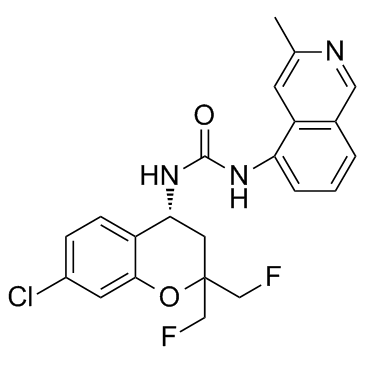| Description |
A-1165442 is a potent, competitive and orally available TRPV1 antagonist with an IC50 of 9 nM for human TRPV1.
|
| Related Catalog |
|
| Target |
IC50: 9 nM (human TRPV1)[1]
|
| In Vitro |
A-1165442 displays potent, competitive antagonism at recombinant human TRPV1 activated by capsaicin (IC50=9 nM) and incomplete blockade of acid-evoked response (62% block at 30 μM). A-1165442 possesses excellent selectivity (>100-fold) versus other members of the TRP family (TRPA1, TRPM8, TRPV2, TRPV3) and other receptors expressed in peripheral sensory neurons including P2X2/3, Cav2.2, Nav channels, and KCNQ2/3. A-1165442 shows minimal cross-reactivity upon evaluation (10 μM) in a broad screening panel (n=74, CEREP) of cell-surface receptors, ion channels, and enzymes[1].
|
| In Vivo |
A-1165442 exhibits excellent pharmacological selectivity, has a favorable pharmacokinetic profile, and demonstrates good efficacy against osteoarthritis pain in rodents. Oral administration of A-1165442 prevents capsaicin-induced nocifensive behaviors in rats, with an ED50 of 9.5 μmol/kg corresponding to plasma concentration of 420 ng/mL (970 nM). A single dose of A-1165442 produces a robust effect on grip force, with an ED50 of 35 μmol/kg measured 1 h postdosing. Repeated dosing of A-1165442 results in an increase in potency relative to acute analgesic efficacy. No significant changes in core body temperature is observed in conscious rats dosed with A-1165442 and this temperature-neutral profile is maintained in conscious dogs[1].
|
| Animal Admin |
Dogs: Male beagle dogs are instrumented with telemetry transmitters capable of monitoring core body temperature and then allowed to recover. Dosing is initiated at time zero, with dogs receiving a single oral dose of vehicle, compound 1 at (30 μmol/kg), or A-1165442 (100 μmol/kg); n=4−6 per group. Measurements are recorded every 5 min for the duration of the study, then averaged to 15 min and 1 h intervals. Temperature signals are transmitted as radio signals by each implanted transmitter to a receiver placed on the cage and interfaced with a desktop personal computer[1].
|
| References |
[1]. Voight EA, et al. Discovery of (R)-1-(7-chloro-2,2-bis(fluoromethyl)chroman-4-yl)-3-(3-methylisoquinolin-5-yl)urea (A-1165442): a temperature-neutral transient receptor potential vanilloid-1 (TRPV1) antagonist with analgesic efficacy. J Med Chem. 2014 Sep 11;57(17):7412-24.
|
